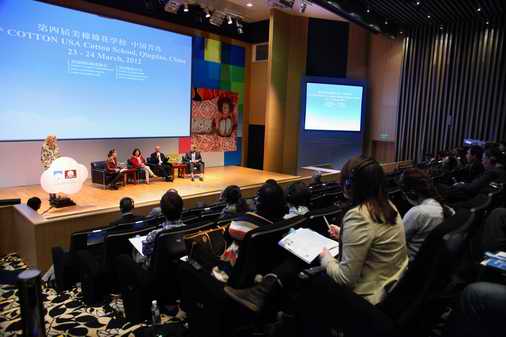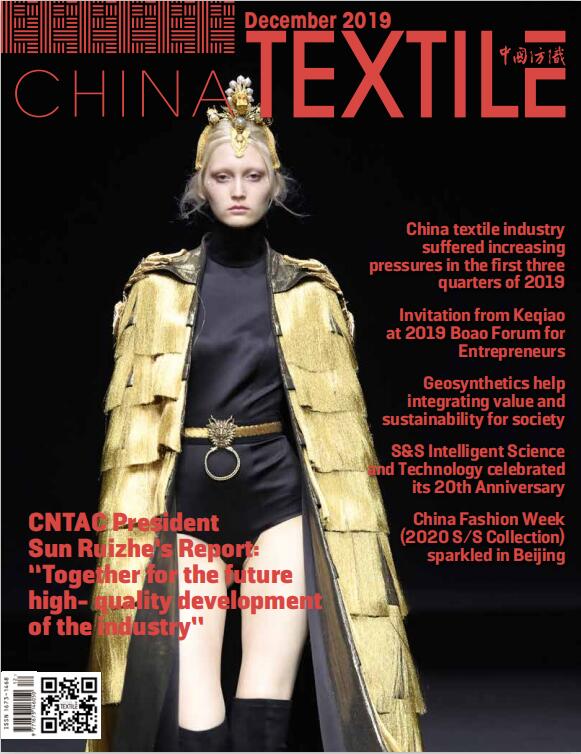Cotton School Tells Us More
May 07, 2012 | by

Sponsored by Cotton Council International (“CCI”), the fourth COTTON USA Cotton School convened in the city of Qingdao, Shandong province, China, from March 23 to 24, 2012. Over 180 representatives of 97 renowned cotton textile enterprises from China, Hong Kong and Southeast Asia attended the event.
During the two-day session, professionals from the U.S. cotton industry, senior representatives from Chinese and Southeast Asian cotton textile enterprises as well as government officers from China Cotton Association and China National Textile and Apparel Council were invited to deliver speeches aiming at helping the enterprises develop an in-depth understanding of U.S. cotton from the aspects of cotton varieties, growing regions, classification system, planting, production and application as well as the purchase procedures of raw cotton and risk management. During the event, CCI also held panel discussions to exchange ideas about the current status of the global, Chinese and U.S. cotton and textile industries.
Cotton is one of the main natural fibers for textile products manufacture, and the purchase of cotton is recognized as the most important part for yarn spinning. Recently, China is the largest importer of U.S. cotton. Due to the short cotton supply in the domestic market, Chinese cotton textile enterprises gradually rely on imported cotton as a source of raw materials.
Acting as a promotion organization of U.S. cotton industry in the global market, CCI attaches great importance to the long-term partnerships with cotton farmers, international cotton merchants, associations and the cotton textile enterprises around the world. To enable the cotton textile enterprises in China as well as in Southeast Asia to develop a further understanding of the U.S. cotton industry, CCI has convened the COTTON USA Cotton School in China every two years since 2006. Through lectures, panel discussions and interactive sessions, enterprises gain a comprehensive understanding of the U.S. cotton industry and system in terms of planting, production, classification, trade, contract sanctity and purchase of raw cotton which is helpful for them to purchase the cotton most suitable for their needs so as to effectively control and reduce the purchasing cost and increase the profit to the utmost extent. CCI’s three previous COTTON USA Cotton School programs were fully subscribed with participation from China’s largest mills and manufacturers – most of whom are COTTON USA licensees.
During the one-and-half day Cotton School agenda: Ms. Karin Malmstrom, Director of CCI China, hosted the session; Mr. Kevin Latner, new Executive Director of CCI, delivered a welcome speech, cotton professionals from United States Department of Agriculture, American Cotton Shippers’ Association, National Cotton Council of America, AMCOT, Supima Association of America and Cotton Incorporated delivered presentations; and representatives from both the China Cotton Association and China National Textile and Apparel Council were invited to make speeches on the cotton and textile industrial development situations in China.
“The U.S. is a long-term partner with China for providing high quality cotton to satisfy import requirements. For enterprises good, reliable raw materials not only can fundamentally ensure high-quality products, but also are essential to strengthening core competitiveness. As global cotton textile industries have experienced structural changes during 2010 and 2011 along with the unprecedented fluctuation of cotton prices, soaring labor costs and appreciation of the RMB, so too do Chinese textile enterprises continue to cope with great challenges from both domestic and overseas markets. At present, the cotton market has reached a comparatively reasonable level of stabilization. Due to a number of factors including the European debt crisis, sluggish global economic recovery, fluctuating commodity prices and exchange rates as well as credit shrinkage, textile enterprises continue to explore ways to survive in such an unpredictable macro-environment,” said Ms. Karin Malmstrom.
During this year’s Cotton School, Mr. Mark Lange, President and CEO of the National Cotton Council of America delivered a detailed presentation regarding the current cotton industrial development trend in the US and global market, as well as U.S. Cotton ginning practices.
In addition, during the first day session, experts from American cotton industries communicated with U.S cotton customers offering them explanations on those issues they would frequently encounter when purchasing and using U.S cotton such as the U.S. cotton classification system, growing regions, standard purchase procedures, contract performance and risk management etc. Besides, representatives from Zibo Lanyan Group Co., Ltd., Central Textiles (H.K.) Ltd. and the Thai Alliance Textile Co., Ltd. shared with other participants their experiences using U.S. Cotton and the application of Cotton Incorporated’s EFS System.
The second day sessions covered the fields of the textile industry and brand sourcing from Hong Kong, Thailand and South Korea, the domestic and international cotton industrial market environment, industrial status and prospect, challenges and opportunities facing textile manufacturers, sourcing trends of the global and U.S. retail markets as well as fabrics and garment retail market trends. Cotton Incorporated’s U.S. retail market information and fashion trends report 2012 offered in-depth analyses of the current retail market status and consumers’ purchasing behaviors.
As one of the highlights of this year’s event, Ms. Gao Fang, Executive Vice President of China Cotton Association, was especially invited to deliver a detailed speech on the current cotton supply and demand as well as the consumption status in domestic Chinese market. In addition Mr. Sun Huaibin, Spokesman and Director of News Center of China National Textile and Apparel Council and Director of China Textile Economics Research Center, offered the attendees an analysis of the textile industrial development and prospect in China. The participants were not only able to develop in-depth knowledge of U.S. cotton, but also could have a comprehensive understanding of the macro and micro environments and development trends currently facing China and the global textile supply chain.
Most all the participants have reached the consensus that the Cotton School program is considerably constructive, productive with practical value. The session not only provides the cotton textile enterprises with the latest market information, but also presents itself as a high-quality international event. Through the COTTON USA Cotton School CCI performs its role as an internationally bridge to promote the exchange and communications between the Chinese and US cotton industries, boost the prosperous development of cotton textile industries, and create a win-win dialogue environment among all participants.
To familiarize participants with CCI’s current promotions theme in China – “COTTON USA: Naturally Color Your World”, a colorful video and photo exhibition featuring the campaign’s signature elements including the American Quilt, modeling competition and nation-wide road show is on display within the meeting area.



